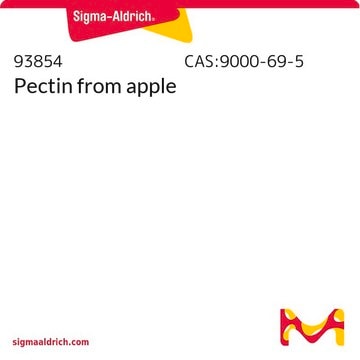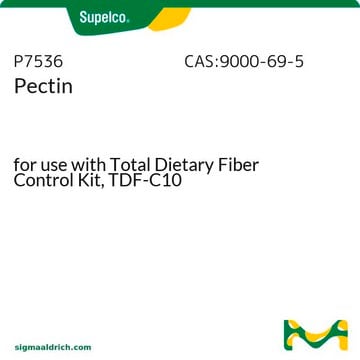This item does gel in the presence of divalent cations such as calcium or magnesium. Please review the batch-specific certificate of analysis for information on the Galacturonic Acid and methoxy content.
P9135
Pectin from citrus peel
Galacturonic acid ≥74.0 % (dried basis)
Synonyme(s) :
Poly-D-galacturonic acid methyl ester
About This Item
Produits recommandés
Source biologique
citrus (peels)
Niveau de qualité
Forme
powder
Composition
Galacturonic acid, ≥74.0% (dried basis)
Impuretés
≤10% Moisture
Couleur
light brown
Température de stockage
room temp
Vous recherchez des produits similaires ? Visite Guide de comparaison des produits
Description générale
Application
- in the comparative study of physicochemical, rheological and gelling properties of pectin among different extraction method[2]
- in starch suspension for measuring in vitro starch digestibility[3]
- to measure pectinase activity[4]
- in the production of pectinase on solid medium[5]
Actions biochimiques/physiologiques
Autres remarques
Code de la classe de stockage
11 - Combustible Solids
Classe de danger pour l'eau (WGK)
nwg
Point d'éclair (°F)
Not applicable
Point d'éclair (°C)
Not applicable
Équipement de protection individuelle
Eyeshields, Gloves, type N95 (US)
Faites votre choix parmi les versions les plus récentes :
Certificats d'analyse (COA)
Vous ne trouvez pas la bonne version ?
Si vous avez besoin d'une version particulière, vous pouvez rechercher un certificat spécifique par le numéro de lot.
Déjà en possession de ce produit ?
Retrouvez la documentation relative aux produits que vous avez récemment achetés dans la Bibliothèque de documents.
Les clients ont également consulté
-
What is the methylation degree of this pectin? Does it gel in presence of Ca2+ ions?
1 answer-
Helpful?
-
-
How can I determine the shelf life / expiration / retest date of this product?
1 answer-
If this product has an expiration or retest date, it will be shown on the Certificate of Analysis (COA, CofA). If there is no retest or expiration date listed on the product's COA, we do not have suitable stability data to determine a shelf life. For these products, the only date on the COA will be the release date; a retest, expiration, or use-by-date will not be displayed.
For all products, we recommend handling per defined conditions as printed in our product literature and website product descriptions. We recommend that products should be routinely inspected by customers to ensure they perform as expected.
For products without retest or expiration dates, our standard warranty of 1 year from the date of shipment is applicable.
For more information, please refer to the Product Dating Information document: https://www.sigmaaldrich.com/deepweb/assets/sigmaaldrich/marketing/global/documents/449/386/product-dating-information-mk.pdfHelpful?
-
-
How is shipping temperature determined? And how is it related to the product storage temperature?
1 answer-
Products may be shipped at a different temperature than the recommended long-term storage temperature. If the product quality is sensitive to short-term exposure to conditions other than the recommended long-term storage, it will be shipped on wet or dry-ice. If the product quality is NOT affected by short-term exposure to conditions other than the recommended long-term storage, it will be shipped at ambient temperature. As shipping routes are configured for minimum transit times, shipping at ambient temperature helps control shipping costs for our customers. For more information, please refer to the Storage and Transport Conditions document: https://www.sigmaaldrich.com/deepweb/assets/sigmaaldrich/marketing/global/documents/316/622/storage-transport-conditions-mk.pdf
Helpful?
-
-
Hi, i want to know what is funcional groups of pectin from citrus peel(product number is P9135)?
1 answer-
This product is tested for galacturonic acid content and the percentage of methoxy groups. The material will demonstrate a minimum of 74% and and 6.7%, respectively. The degree of esterification is not reported on a lot to lot basis. However, historical data indicates this item is approximately 55 – 65% esterified. The structure of this material has not been further investigated. Please see the link below to review additional information regarding the general structure of pectin: https://www.researchgate.net/publication/281388262_A_review_on_pectin_Chemistry_due_to_general_properties_of_pectin_and_its_pharmaceutical_uses
Please see the link below to review a sample or lot specific Certificate of Analysis:
https://www.sigmaaldrich.com/product/sigma/p9135#product-informationHelpful?
-
-
Is this a high methoxyl pectin or a low methoxyl pectin
1 answer-
This material is from citrus peel, which would be considered a high methoxyl source. The product is not tested on a lot to lot basis for the degree of esterification. However, historical data indicates this pectin is 55 - 65% esterified.
Helpful?
-
-
Is there a product available for pectin staining that utilizes a one-step method instead of two antibodies?
1 answer-
Pectin, or pectic substances, are a group of closely associated polysaccharides found in plant cell walls. They play a role in various physiological processes such as cell growth and differentiation, contributing to the integrity and rigidity of plant tissue.
There are several products available for Ruthenium Red, including catalog numbers 00541, R2751, and 557450. However, none of these products has been specifically tested for suitability in pectin staining during quality control, so it is uncertain which one might be the most appropriate.
It is expected that cotton blue in lactophenol is not necessary when staining for pectin.Helpful?
-
-
What is the degree of esterification of this pectin?
1 answer-
The degree of esterification is not performed as a quality test on a batch-wise basis. However, information does exist that suggests it may be between 4-10%. It is suggested to assay the degree of esterification. There are reports in the scientific literature as to how to determine the degree of esterification. Please see the citation below for more details.
Benassi L, Alessandri I, Vassalini I. Assessing Green Methods for Pectin Extraction from Waste Orange Peels. Molecules. 2021 Mar 21;26(6):1766. doi: 10.3390/molecules26061766. PMID: 33801127; PMCID: PMC8004147.
Helpful?
-
-
What is the molecular weight of this pectin
1 answer-
The molecular weight may range from as low as 10 kDa to as high as 300 kDa. Historical information suggests a mid-range of 23 kDa to 71 kDa.
Helpful?
-
-
WHAT IS THE AVERAGE MOLECULAR WEIGHT OF THIS PRODUCT?
1 answer-
The molecular weight of this product is not determined. As this is a Quality Level 200 product, there are multiple qualified suppliers that may change from lot to lot. Pectin is composed primarily of polygalacturonic acid, however the metoxylation/esterification is quite variable. The molecular weight may range from as low as 10 kDa to as high as 300 kDa. Historical information suggests a mid-range of 23 kDa to 71 kDa.
Helpful?
-
Active Filters
Notre équipe de scientifiques dispose d'une expérience dans tous les secteurs de la recherche, notamment en sciences de la vie, science des matériaux, synthèse chimique, chromatographie, analyse et dans de nombreux autres domaines..
Contacter notre Service technique








